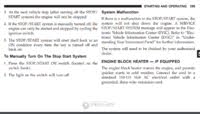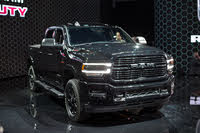I have a 2017 2500 ram diesel, 4x4. How do I operate the 4 wheel drive system?
10 Answers
owners manual says nothing about a manually operated 4x4 system smart ass! Only the automatic system
Page 399 in the online owners manual. Don't throw around insults when you can't operate an index or have reading comprehension issues.
Manually Shifted Transfer Case — If Equipped The transfer case provides four mode positions: • Two-Wheel Drive High Range (2H) • Four-Wheel Drive Lock High Range (4H) • Neutral (N) • Four-Wheel Drive Low Range (4L) For additional information on the appropriate use of each transfer case mode position, see the information below: 2H Two-Wheel Drive High Range — This range is for normal street and highway driving on dry, hard surfaced roads. 4H Four-Wheel Drive Lock High Range — This range locks the front and rear driveshafts together forcing the front and rear wheels to rotate at the same speed. Additional traction for loose, slippery road surfaces only. NEUTRAL (N) Neutral — This range disengages both the front and rear driveshafts from the powertrain. To be used for flat towing behind another vehicle. Refer to “Recreational Towing” in “Starting And Operating” for further information. 5 STARTING AND OPERATING 399 4L Four-Wheel Drive Low Range — This range locks the front and rear driveshafts together forcing the front and rear wheels to rotate at the same speed. Additional traction and maximum pulling power for loose, slippery road surfaces only. Do not exceed 25 mph (40 km/h). This transfer case is intended to be driven in the 2H position for normal street and highway conditions such as dry, hard surfaced roads. When additional traction is required, the 4H and 4L positions can be used to lock the front and rear driveshafts together and force the front and rear wheels to rotate at the same speed. This is accomplished by simply moving the gear selector to the desired positions once the appropriate speed and gear requirements are met, refer to “Shifting Procedure – Manually Shifted Transfer Case” in this section for further information. The 4H and 4L positions are intended for loose, slippery road surfaces only. Driving in the 4H and 4L positions on dry, hard surfaced roads may cause increased tire wear and damage to the driveline components. The “Transfer Case Position Indicator Light” in the instrument cluster will alert the driver that the vehicle is in four-wheel drive and that the front and rear driveshafts are locked together. This light will illuminate when the transfer case is shifted into either the 4H or 4L position. There is no light for the 2H or NEUTRAL positions on some models. When operating your vehicle in 4L, the engine speed is approximately three times that of the 2H or 4H positions at a given road speed. Take care not to overspeed the engine and do not exceed 25 mph (40 km/h). Proper operation of four-wheel drive vehicles depends on tires of equal size, type and circumference on each wheel. Any difference will adversely affect shifting and can cause damage to the drivetrain. NOTE: Do not attempt to make a shift while only the front or rear wheels are spinning, as this can cause damage to drive line components.
BTW - Reading your owners manual is the best advice any new car owner can receive. A very large percentage of the questions asked on this site could be avoided (and a lot of headaches and costs) if people would simply crack open that book.
Is there a speed rating when shifting into 4 wheel high ????
The number I have seen is 50 mph but I limit my speed to maybe 20.
I have a 2500 2013 dodge it will go in 4 wheel high but not 4 wheel low any ideas
Hollywood67 answered 6 years ago
Put your trans in neutral then shift transfer case into 4 Lo. Once light on dash says 4 Lo I shift trans to forward or reverse. That’s how I do it.
to F_O_R PG 399 Does NOT SHOW anything about shifting into 4wd with floor shifter. attached below is a snip it of pg 399


